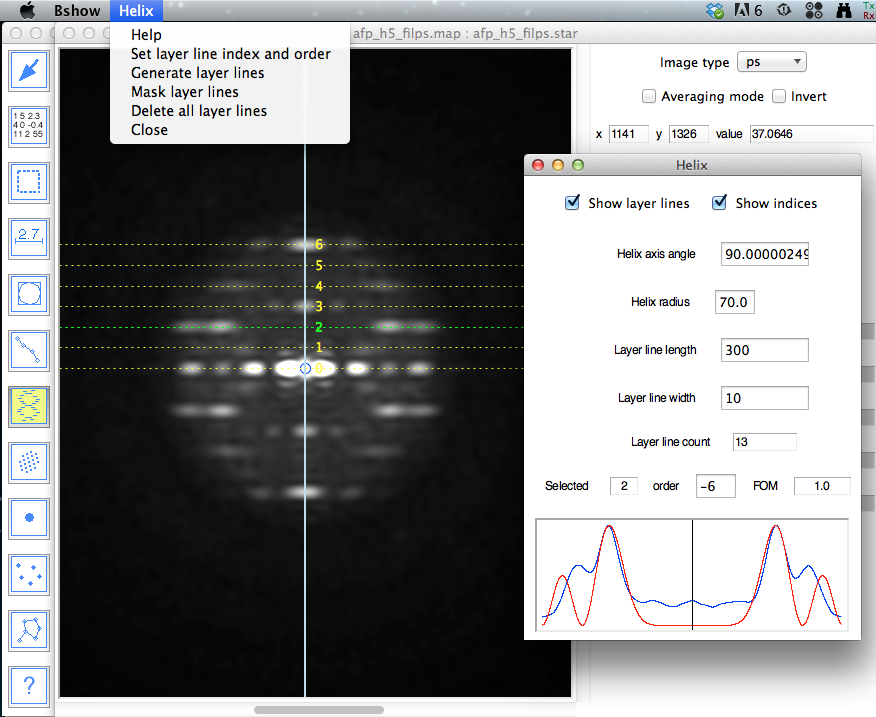![]()
A Fourier transform or power spectrum of an images of a helical specimens
can be analyzed by selecting the "Micrograph/Helix" menu item or
the helix tool (helical diffraction pattern icon). This brings up a new
window with a menu "Helix" and parameters:
- Helix
- Set layer line index - open a dialog box called "Indices" to set the indices of the currently selected reflection.
- Generate layer lines - generates all layer lines from a seed within a given resolution limit.
- Mask layer lines - mask layer lines in a Fourier transform and delete the background.
- Delete all layer lines - delete all layer lines in memory (no recovery!).
- Close - close window and deactivate helix operations.
- Parameters
- Radiobuttons to display/hide layer lines and indices.
- Helix axis angle - sets the helix axis direction relative to the x-axis.
- Layer line length - sets the length for drawing layer lines.
- Layer line width - sets the width for masking.
- Layer line count - shows the number of layer lines.
- Selected - indicates the currently selected layer line, its Bessel order and its figure-of-merit.
- A plot of a selected layer line (blue) and a Bessel function of the indicated order (red).

A power spectrum with helical axis (light blue) and layer lines with indices (yellow). In the "Helix" dialog box, the profile for the second layer lines is shown (blue) with a Bessel function of the indicated order (red).
Setup for helix processing
The image of a helix is read into bshow, and its Fourier transform calculated with the "Image/Fourier transform" menu item. The Fourier transform is then shifted to center the origin with the menu item, "Image/Center origin".
Alternatively, a power spectrum can be generated with the "Image/Power spectrum" menu item. This image cannot be masked and backtransfomed as is possible with the Fourier transform
Picking layer lines
To activate picking layer lines, select the helix tool icon (helical diffraction pattern icon) from the tools window. The helix axis angle should be set to coincide with diffraction pattern. Click on a layer line and then set its index with the "Helix/Set layer line index" menu item. As many layer lines can be picked as needed. The rest of the layer lines can then be generated using the "Helix/Generate layer lines" menu item and setting a resolution limit.
Checking Bessel function fits
The peaks in the profile of a layer line can be fitted with one or more Bessel functions. To test a particular fit, select a layer line and set the order to a desired value. The profile is shown as a blue curve in the plot on the "Helix" dialog window, and the Bessel function as a red curve.
Masking
With any number of defined layer lines defined in a Fourier transform, they can be masked using the "Helix/Mask layer lines" menu item. The "Layer line width" in the crystallography window is used to determine the mask width for each layer line. The Fourier transform can then be backtransformed to produce a new image with most of the background removed.
Mouse controls for picking reflections
- Left/middle button: create or select a layer line
- Shift - left/middle button: delete a layer line
Clicking the left or middle mouse button in an empty region on the image creates a new reflection. Clicking on an existing layer line selects that layer line, that can then be moved. To delete a layer line, hold down the shift key and click the left or middle button on the layer line.
Reading and saving crystallographic parameters
The "Micrograph/Read parameters" and "Micrograph/Write parameters" menu items are used to read and write parameter files (usually in STAR or XML format).